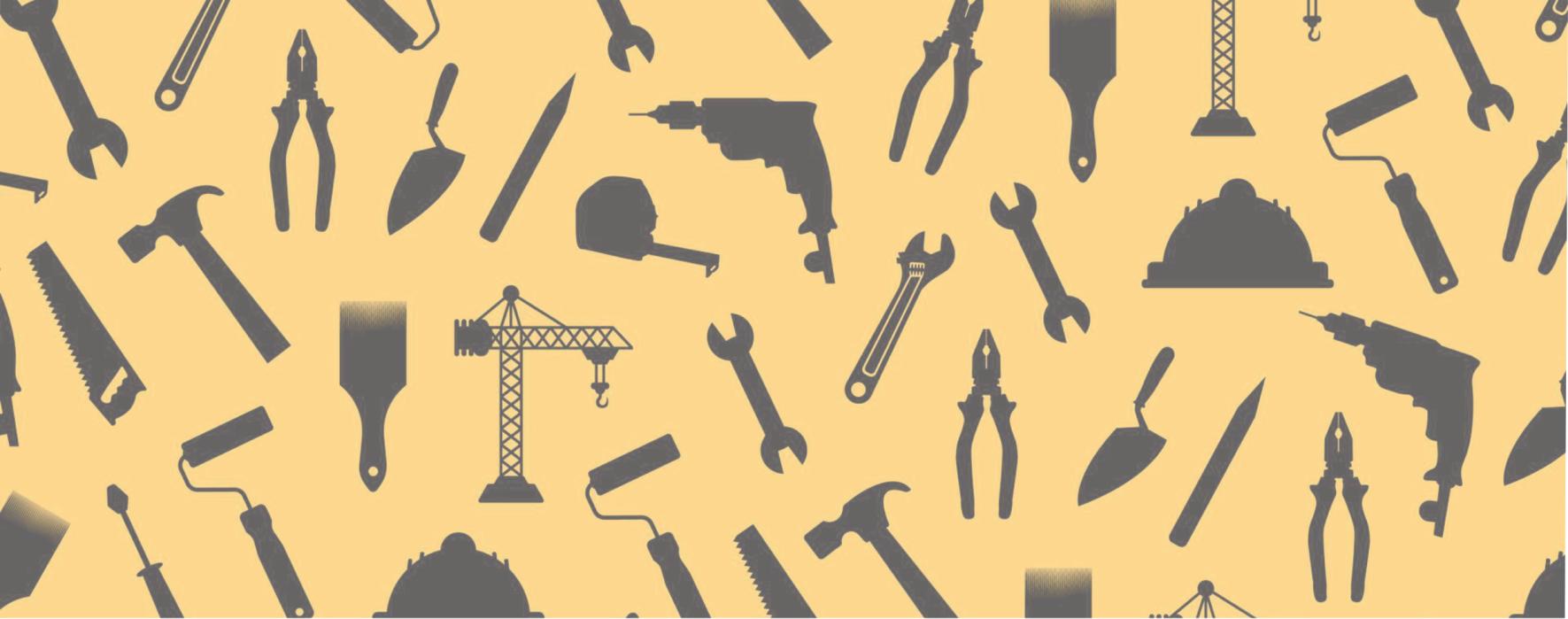
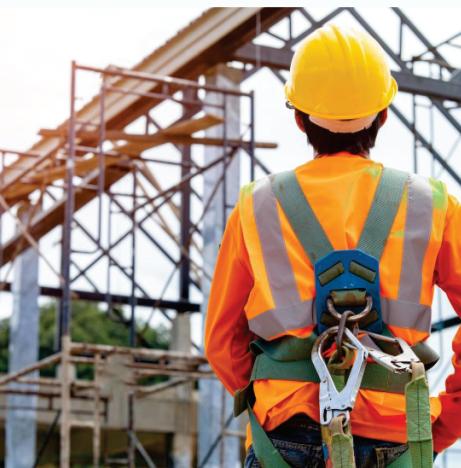





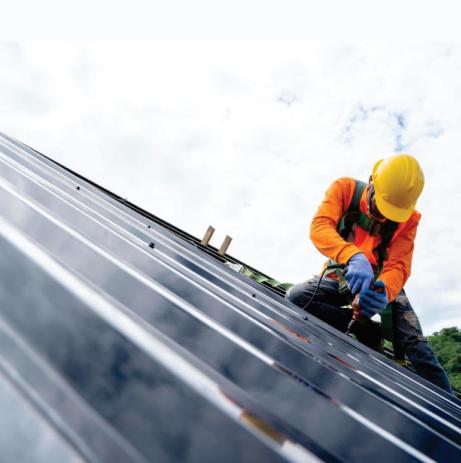

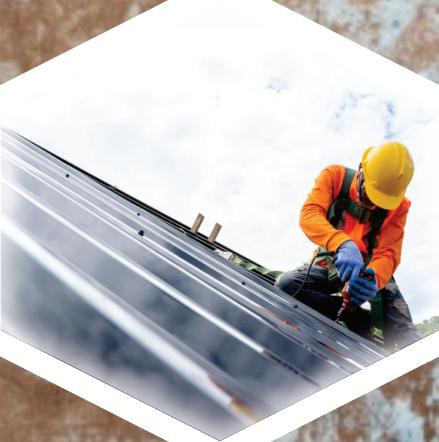
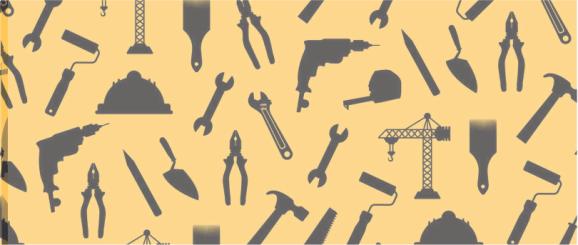












Generally, people don’t think about roof maintenance until a massive leak appears once the rainy season sets is.
Just think of the worst-case scenario; you are at work or away for the weekend and return to a flooded house with your recently cleaned carpets destroyed, damaged walls and even electrical equipment no longer working owing to water seeping in through your roof. This is exactly why homeowners should take roof maintenance more seriously.
A roof requires ongoing maintenance to prevent leaks, to identify minor problems before they become major costly problems and maximise the amount of time before needing to replace your roof. This article gives some practical information on how roofs function and how they should be maintained.
Regular inspection and maintenance of your roof is needed to reduce the likelihood of premature leaks and aging. On a daily basis roofs are exposed to sunlight, rain, hail wind and temperature changes that gradually break down the roofing materials. Eventually the replacement of the roof will be necessary. However, with proper maintenance and care the service life of the roof can be maximised.
Given proper maintenance, roofing systems can have a “leak-free life”. Provided the roof has been properly designed, constructed and maintained, the roof should not leak over this time span. After this time the roof system may continue to provide many years of service, but leaks should be expected, increasing in frequency and severity, until such time as the roof requires replacement.
Unscheduled maintenance and repairs may be needed to fix damage to a roof that may have occurred during a severe encounter with the South-Easter down in the Cape of Storms, or other extreme weather event.
Carrying out proper maintenance and identifying potential problems prior to experiencing an actual roof failure will reduce the likelihood of costly premature damage. If a leak occurs through a portion of the roof and goes undetected for a period of time you may experience damage to the building structure and interior finishes.
Roofs should be inspected once a year at the end of the dry season to address any damage that may have occurred and prepare for the upcoming wet season. Your roof should also be inspected after any storm with high winds (checking for loose, broken or missing tiles, for example), extreme rain or hail, or if construction has taken place on the roof area. The inspection should also include the underside of roof structure or decks and the outside of the building as these areas may indicate potential problems with your roof. Skylights and other roof penetrations may require spe-

cialised attention and specific knowledge of how these fixtures interact with the roof assembly. Roofing contractors are generally equipped with the tools and skills to perform the required maintenance to the roof. The contractor will be able to replace damaged materials, perform the cleaning and upkeep of drains and gutters, and can re-secure metal flashings and re-apply any sealant that has failed.
All roofs require regular inspection and maintenance. This should be done by a professional roofing contractor as it involves specialised knowledge, equipment, training and safety requirements.
Here are some self-service tips on roof maintenance: 1. Inspections
Regularly inspect your roof for signs of damage at least twice a year, especially before and after major weather events. Look for signs of damage, water stains or mould.
2. Debris removal
Remove leaves, branches and other debris from the roof and gutters to prevent water pooling and damage.
3. Ventilation
Ensure proper ventilation: Good airflow in the roof cavity helps prevent dampness and rot.
4. Addressing damage
Don’t ignore minor cracks or leaks, as they can worsen quickly. Replace damaged tiles and roof sheets, and gutters.
5. Overhanging branches
Trim overhanging branches as these can cause blockages and damage to the roof and gutters.
7. Professionl help:
Seek professional assistance when it comes to repairing major roof damage, not only to protect your roof but your entire home as well.


Een van die belangrikste besluite wat enige huiseienaar moet neem wanneer ’n bouprojek of opknapping beplan word, is die keuse van die regte bouer.
’n Betroubare en ervare kontrakteur beskerm nie net jou belegging nie, maar verseker ook dat die eindresultaat aan jou verwagtinge voldoen.
’n Goeie bouer bring meer as net handvaardigheid na die tafel. Hulle werk dikwels nou saam met argitekte, help om tydlyne te hou, bied vernuwende ontwerpidees en stel realistiese kosteberamings op grond van voorlopige planne op. Hulle kan ook waarde toevoeg deur kostebesparende voorstelle te doen, hoëgehalte materiaal aan te beveel en potensiële bouprobleme vroegtydig te identifiseer. Verskillende soorte bouers
Verskeie soorte bouers werk in die mark:
Eenman-sakeonderneming: Dié solo-bouers is ideaal vir kleiner projekte soos opknappings. Hulle is dikwels die goedkoopste opsie, maar neem gewoonlik slegs een projek op ’n keer aan.
Kleinspan-bouers: Hierdie bouers begin klein en brei geleidelik hul span uit. Hulle is dikwels ambisieus en gefokus op kliëntetevredenheid, wat waarde vir geld beteken.
Kontrakteurs met subkontrakteurs: Hulle bied ’n balans tussen ’n professionele diens, goeie organisasie en kostebeheer. Let egter op of subkontrakteurs in die kontrak ingesluit en hulle behoorlik verseker is.
Groot boufirmas: Hierdie gevestigde maatskappye is ideaal vir grootskaalse projekte. Hoewel hulle duurder is, bied hulle hoëgehalte werk, vinniger voltooiing en finansiële sekuriteit.
Hoe om ’n betroubare bouer te kies
Die soort bouer wat jy kies, hang af van die omvang van

Kies die regte bouer vir jou projek.
jou projek.
Vir grootskaalse konstruksie is dit raadsaam om ’n bouer te kies wat by die Nasionale Huisbouers Registrasieraad (NHBRC) geregistreer is.
Hierdie liggaam beskerm huiseienaars en stel boustandaarde vas.
’n Geregistreerde bouer by die NHBRC moet ’n Standaard-huisbouwaarborg uitreik.
Hierdie waarborg sluit die volgende in:
Herstel van defekte binne 90 dae ná okkupasie.
Regstelling van daklekkasies binne 12 maande.
’n Vyfjaarstruktuurwaarborg.
Indien ’n geregistreerde bouer in gebreke bly, kan ’n geldige klagte by die NHBRC ingedien word, mits dit oor strukturele probleme gaan.
Praktiese wenke
Kry eers volledige bouplanne voordat jy kwotasies aanvra.
Bepaal of jy ’n spesifieke spesialis of algemene bouer benodig.
Laat een hoofkontrakteur die projek bestuur.
Gebruik mededingende kwotasies, maar vergelyk appels met appels.
Sluit ’n duidelike boukontrak in, met bepalings oor veranderinge of vertragings.
Stel teen voltooiing ’n finale inspeksielys op om misverstande te voorkom.
Met die regte voorbereiding en ondersteuning van instansies soos die NHBRC, hoef die bouproses nie ’n stresvolle proses te wees nie – net die begin van ’n droom wat waar word.














While the drive to eliminate plastic straws and single-use plastics was an eye opener in the push to adopt more sustainable and green lifestyles, for South African homeowners the need to adapt to the persisting electricity and water crises are likely to be a major boost for green home features according to the Seeff Property Group.
Globally, the drive to more sustainable living has gained significant momentum over the last decade.
Locally too, greening is gaining momentum, especially in and around homes. If you have not yet considered introducing green features into your home, then now is the time to start, says Seeff. Green features are not just a good investment but given the realities of the electricity and water crises, buyers are now likely to be swayed by these additions.
Turning the housing sector green is just one of the pillars of government’s green economic strategy. Already, most new developments boast greening elements. Beyond just taking measures to reduce your carbon footprint and impact on the environment, the move to greening homes is a vital economic boost.
What should households be doing?
needs but can power your home including the security system, vital during power outages when homes and neighbourhoods become vulnerable.
At the very least, an inverter system is a worthwhile investment as it can power your security system, internet and television and ensure that you can still charge your phone. These can be integrated with your current electricity system for a seamless switch-over during an outage, ensuring continued power for vital lights, appliances and so on.
To ensure you are not left in total darkness, consider rechargeable LED light fittings or those which can be plugged in at various spots around the home. They charge when the electricity is on and will then come on automatically when the power is out.

By now, all homes should be focusing on water saving and cutting back on electricity usage. Basics such as installing energy efficient lights, turning off lights and appliances when not in use and adjusting your geyser and fridge temperatures can make a broader difference.
There should also now be a focus on energy-efficient appliances and don’t forget to focus on water-consumption when choosing a washing machine. Aside from the hygienic benefits, a dishwasher also uses less water than hand washing.
Features such as solar panels, rainwater tanks, double glazing, well-points and boreholes are now becoming important features for any home.
Solar heating (if you don’t already have that) will not only save on electricity costs and power your hot water
It goes without saying that gas-powered cooking appliances are now almost a necessity while indoor braais and wood-burning fireplaces will be highly sought-after when winter sets in. Another must-have is a rainwater storage tank and grey-water system to provide for garden and outdoor water needs while a more sophisticated system for indoor non-potable needs such as toilets will certainly add further value.
A water purification system in the home will also likely become a future need.
Water-wise gardens are another important aspect of green-homes. By focusing on indigenous plants, you can reduce the water consumption and ensure that your garden looks good even during drier seasons. Be sure to make use of a controlled sprinkler system as it uses less water compared to a hosepipe.
Recycling and waste reduction are further areas to focus on.
Properties with large gardens could incorporate a compost system for fruit, vegetable and other suitable waste.
Additionally, all homes should by now be adopting recycling as most neighbourhoods have some kind of recycling initiative.
Soveel mense het die afgelope tyd hulle uitgespreek teen die verpligting om hulle sonkragstelsels te registreer.
1. Lithium ba�erye sowel as sonpanel is ʼn risiko as dit nie reg geïnstalleer en onderhou word nie.
2. Die prokukte se risiko's word nie sommer genoem nie. Daarom is daar ‘n gesertifiseerde lys van produkte wat goedgekeur is vir gebruik
3. Die standaard vereistes vir registrasie is om die huiseienaar en die Eskom grid te beskerm.
4. Maandelikse besparing op aankoop van stygende elektrisiese kostes omdat jy grotendeels self voorsien
HOEKOM:
1. Wanneer Lithium ba�erye begin warm word laat dit ʼn gi�ige gas vry en die brand kan nie gestop word nie, dit moet uitbrand
2. Wanneer sonpanele begin brand laat dit ook gi�ige gasse vry en solank die son daarop skyn bly dit brand.
4. Nie net u geliefdes en eiendom is in gevaar nie, u bure loop ook deur
5. Versekeraars mag weier om skade weens swak installasies uit te betaal. ʼn COC is geen waarborg dat ʼn installasie korrek gedoen is nie. Professionele ingenieurs neem die risiko as hulle ‘n sisteem a�eken. Om munisipale regulasies na te kom maak beslis sin.
VOORDELE:
1. Finansiele besparing vir minder krag aankope as u sisteem korrek geinstalleer en gekonfigureer is.
2. Met registrasie van u stelsel word ʼn 2-rigting meter geïnstalleer U oorproduksie word na die munisipaliteit gevoer en gemeet. U word daarvoor gekrediteer.
Complete Intelligence Assistance is die registrasie kantoor wat u gemoedsrus gee. Skakel of WhatsApp 061 540 4508.




Dink aan jou loodgieterstelsel as die spysverteringstelsel van jou huis. Gereelde onderhoud voorkom duur noodherstelwerk en verseker dat jou huis gesond bly. Hier is belangrike riglyne vir die instandhouding van jou water- en pypstelsels:
Goeie gewoontes
1. Wees bewus wat nie in afvoerpype hoort nie:
Toilet: Moenie sanitêre produkte, wattepluisies, papierdoeke, babadoeke, doeke, sigarette of hare probeer wegspoel nie.
Wasbak: Moenie verfverdunner, spek-ghries, olie of groot hoeveelhede kos wegspoel nie.
2. Jaarlikse pyp-inspeksies: Laat 'n professionele loodgieter alle sigbare pype, drukking in waterlyne en aansluitings nagaan om potensiële probleme vroegtydig op te spoor.
3. Vermy winkelrak-skoonmakers: Die meeste

kommersiële skoonmaakmiddels bevat sterk chemikalieë wat metaal- en plastiekpype kan beskadig. Raadpleeg eerder ’n loodgieter vir veilige oplossings. Voorkomende opgraderings
1. Isoleer jou pype: Pypisolasie verminder kondensasie, voorkom skimmelgroei en help om waterskade te vermy. Dit hou ook vogvlakke in jou huis onder beheer.
2. Installeer lekkasie-opspoorders: Selfs ’n klein lekkasie kan derduisende rand se waterskade veroorsaak. Moderne detektors kan jou selfs per foon waarsku wanneer ’n probleem ontstaan.
3. Gebruik waterpyp-hamerwerende toestelle: Hierdie toestelle voorkom die kloppende klank en skade wat ontstaan wanneer huishoudelike toestelle se watertoevoer vinnig afskakel.
4. Installeer ’n water-“versagter”: ’n Waterversagter help op plekke met sogenaamde “harde water” om kalk en minerale te verwyder wat lae waterdruk en korrosie veroorsaak.
5. Voeg ’n sweet-werende klep by jou toilet: In warm, vogtige klimaat voorkom dit dat kondensasie van jou toilet op die vloer drup.
Professionele dienste
1. Lekkasie-opsporing: Professionele loodgieters gebruik gevorderde toerusting om versteekte lekkasies in mure, onder betonblaaie en in ander moeilik bereikbare plekke op te spoor voordat dit ernstige skade veroorsaak.
2. Terugvloei-voorkoming: Terugvloei-toestelle voorkom dat drinkwater in die verkeerde rigting vloei en besoedel word. Gereelde inspeksie van hierdie toestelle is belangrik:
Druk-vakuumbrekers
Verminderde druk-voorkoming
Dubbelklepstelsels
3. Vervanging van pype: Tradisionele koperpype verswak mettertyd. Oorweeg die vervanging van verouderde pype met moderne PEX-pype wat meer duursaam is, vriesbestand is en langer hou.
Hierdeur kan jy nie net duur noodherstelwerk keer nie, maar ook die lewensduur van jou water- en pypstelsels verleng en die watergehalte in jou huis verbeter.


































As a result of the energy crisis and growing environmental concerns, installing ceiling insulation has been a stipulation of South African National Standards (SANS) legislation since 2013.
In an effort to reduce demand for additional heating and cooling measures the SANS 10400-XA building laws were published, stipulating minimum R-values for roofing insulation according to the various climate zones.
“Homeowners who want to reduce reliance on heating and cooling measures ought to scroll down to the map of climate zones found on page 12 of this document,” advised Adrian Goslett, Regional Director and CEO of RE/MAX of Southern Africa, “to enable them to check that the installed insulation has the correct insulation value to handle the heating and cooling requirements of their particular climate zone.”
According to a renewable-energy company homeowners will need insulation that is at least 135 mm thick in Johannesburg, Pretoria and the Western Cape. This lowers to 100
mm in a humid climate such as KwaZulu-Natal. Although the ceiling insulation price will increase depending on the thickness of the product, it is advisable to purchase thicker insulation to ensure maximum insulation.
Said Goslett: “When choosing insulation, homeowners should also consider that certain products – cellulose insulation, for example – compress a few months after insulation, which lowers the R-value and reduces its effectiveness. Homeowners should, therefore, make a point to ask the insulation company whether its chosen insulation will settle over time and whether the selected thickness will then compensate for this compression over time.”
Certain insulation could also add more value to a home than others. For example, Isotherm has become very popular in South Africa because it is made of recycled plastic bottles and is entirely non-allergenic.
“Because ceiling insulation has become a standard feature homeowners who install popular, high-quality insulation products can later refer to it as an additional desirable feature when marketing their home,” Goslett concludes. “Sometimes it is these that help sellers close a deal.”



















Om die mure en plafonne van jou huis te verf, is ’n groot taak wat beplanning vereis voordat jy begin.
Die regte volgorde vir die verf van enige vertrek is om eers met die plafon te begin, dan die mure en laastens die hout- en metaalwerk soos verkoelers en pype. Beplan altyd jou werk deeglik en werk stelselmatig –só verseker jy dat jy nie dele oorslaan wat later sigbaar sal wees wanneer die verf droog is nie.
Noodsaaklike gereedskap en voorbereidingswenke
Voordat jy enige verf begin aanwend, moet jy eers besluit hoe jy die oppervlak veilig en gemaklik gaan bereik – om met die een voet op ’n stoel te balanseer, is nié die manier nie! Maak die vertrek so leeg as moontlik en skuif enige oorblywende meubels na die middel van die kamer en gooi dit toe met plastiekbedekking. Matte moet ook so beskerm word. As jy nie ’n geskikte leer het nie, kan jy een by ’n plaaslike huurwinkel gaan huur. Verskeie soorte is beskikbaar –sommige vou oop tot ’n werkplatform, wat ideaal is vir die verf van groot oppervlaktes soos plafonne.
hê? Dowwe verf is dikwels die beste keuse, aangesien dit oppervlakgebreke help verbloem.
Wanneer jy plafonne verf, begin in een hoek en werk die kante in terwyl jy aangaan, eerder as om eers die hele omtrek met ’n kwas te verf. Laasgenoemde metode laat dikwels die verf droog word voordat jy die res met die roller verf, wat ’n streperige effek kan veroorsaak. Laat die plafonverf sowat 2 cm teen die muur afstrek – dan hoef jy later net netjies met die muurverf teen daardie randlyn in te sny.
Die proses vir muurverf is dieselfde. Sny in rondom skakelaars en proppe terwyl jy aangaan, en moenie te veel bekommer as jy effens op vensterrame of deurkosyne verf nie – dit is maklik om later netjies met die laaste verwerk af te rond.

Volg ’n paar eenvoudig wenke om jou verfprojek te vergemaklik.
Jy moet ook let op die aard van die oppervlak wat jy gaan verf – is dit grof (soos spuitpleister) of glad gepleister? Dit is belangrik, want dit bepaal watter roller jy moet gebruik en hoeveel voorbereiding nodig is. Tekstuur-plafonne kan met tyd bros en stofagtig raak, veral as dit nog nooit geverf is nie. In sulke gevalle moet jy dit eers met ’n olieverf verseël. Gladde plafonne het dikwels krake wat met die regte vulmiddel herstel moet word. Baie verskillende soorte is beskikbaar. Neem dus jou tyd om die regte een vir jou projek te kies.
Verfwenke
Sodra jy die toegang en voorbereiding uitgesorteer het, moet jy besluit watter soort verf jy gaan gebruik – wil jy ’n dowwe-, eierdop-, halfglans- of hoëglans- afwerking
Die tegniek “insny” is makliker as wat meeste die mense dink. Jy kan spesiale kwaste koop waarvan die hare teen ’n skuins hoek gesny is – ideaal vir presiese werk. Moenie te veel verf met die kwas skep nie –hou dit soos ’n pen vas en begin in een hoek. Begin ’n bietjie onder waar jy die rand wil hê en werk stadig op tot teen die regte lyn. As daar nie genoeg verf op is nie, is dit maklik om weer daaroor te gaan om dit reg te stel. As jy per ongeluk teen die afgewerkte plafon verf, wag totdat dit droog is en werk dan weer met die plafonverf om die lyn reg te maak. Jy hoef nie die hele plafon oor te verf nie – dis net ’n klein regstelling.
Moenie in die versoeking kom om maskeerband te gebruik nie – verf kruip dikwels onder die rand in, en as jy die band aftrek, kan stukke van die vorige verflaag loskom, wat die kaal pleister sal ontbloot. Jy sal met ’n bietjie oefening met ’n kwas verbaas wees hoe maklik dit is om goeie resultate te kry. Die belangrikste is om jou tyd te neem en netjies te werk.
As jy die muur agter byvoorbeeld ’n lugversorger wil verf sonder om dit af te haal, is rollers ideaal. Hulle werk ook goed in ander moeilik bereikbare dele.











As winter creeps closer it becomes crucial for homeowners to safeguard their valuable investment by ensuring weatherproofing measures.
Shielding your property from impending storms is essential to protect its integrity.
While it may be expensive to make the necessary upgrades any improvement made to the home should be viewed as an investment rather than an expense. “Most upgrades will add value to the property; at the very least it will protect the resale value of the home, as a poorly maintained property is likely to sell for less than a home that is in good condition.
To help homeowners prepare their home for heavy rains and strong winds, RE/MAX of Southern Africa shares some weather-proofing tips.
1. Add a stormwater drain
If your property does not already have a stormwater drain somewhere on the property then this is an important upgrade to make to prevent water pooling along the exterior of the home and causing damage. Those who do already have a drainage system in place need to check it regularly to clear away any debris that could cause blockages.
2. Upgrade wooden frames
If possible, replace any wooden exterior window or door frames with more durable options (such as aluminium) to prevent leaks or rot from occurring. If this is not possible make sure to sand the frames down and varnish them to get them in good condition before the storms.
3. Check the roof and gutters
Another important aspect to maintain is the home’s roof and gutters. As these are tricky places to access many homeowners tend to overlook them. After a storm it is advisable to get up on the roof to check for any damage and/ or blockages that may have occurred. It is also advisable to have the roof cleaned regularly to prevent damage from occurring.
4. Trim back trees
Those with established trees near their home are advised to trim big branches back that may fall and cause damage to the property during a storm. It may also be

worth adding extra topsoil to make sure the plant is not uprooted by any strong winds.
5. Gaps under doors
Large gaps under doors let water and wind in, yet it’s so easy to cover up these areas with a door sweep. You will find draft excluders or door sweeps at your local Builders Warehouse, and there are a variety of options to choose from.
Good to know: In the event a door swells during the rainy season, don’t attempt to sand away any wood from the base of the door. Once the absorbed moisture dries out the wood will return to its previous form and will no longer stick. Sanding the door while it is still swollen will result in an even larger gap once the door returns to its normal state.
6.
It’s always a good idea to give your roof an annual inspection. Tiled roofs fitted with ridge caps that are mortared in place can have the mortar deteriorate over time, and these areas can be the cause of leaks in the roof, as can slipped or broken tiles. On tin roofs rust can eat away at fastenings and result in leaks. While flat roofs can be susceptible to leaks where water has a chance to pool and damage the roof coating.
Maintaining the home becomes even more important for those who are selling over the winter months. Buyers will make lower offers if they see potential issues with the home that they will need to fix. To have the best chance of receiving full price offers sellers should address any issues and make the property as appealing as possible to buyers.
(Sources: Home-Dzine and RE/MAX of Southern Africa)








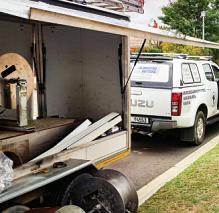















































Aclean, healthy swimming pool doesn’t just happen by itself. It requires consistent care and attention, but the good news is that pool maintenance doesn’t have to be complicated. By focusing on the “Three C’s” — Circulation, Cleaning, and Chemistry — you can keep your pool crystal clear and ready for relaxation year-round.
1. Circulation: Keep water moving
Good water circulation is the foundation of a healthy pool. Your pump is like the heart of your pool system; it draws water through the skimmer, pushes it through the filter and returns it through the jets. This continuous flow removes debris and helps prevent algae growth.
Run your pump for 8-12 hours daily, especially in warmer climates. A variable-speed pump is an energy-efficient option that runs quietly and saves money. Check your filter pressure gauge regularly; if it reads 10-15 psi above normal, it’s time to clean or backwash the filter.
Also, clean the skimmer and pump baskets once or twice a week to ensure water moves freely and reduce strain on the pump. Angle pool jets downward and in a circular motion to help circulate water throughout the pool, including hard-to-reach corners and steps.
2. Cleaning: Remove dirt and debris
Even with good circulation debris can settle and accumulate in low-flow areas. Daily cleaning prevents stains, algae, and murky water.
Brush the walls, steps and corners daily to prevent algae build-up.
Skim the surface to remove floating debris such as leaves and insects.
Vacuum weekly using a manual vacuum or an automatic pool cleaner to remove dirt from the bottom.
Don’t forget to give special attention to “dead spots” such as behind ladders, steps and corners where circulation is weakest.
3. Chemistry: Balance your water
Proper water chemistry keeps your pool clean, clear and safe to swim in. Test your pool water once or twice a week using a quality test kit or strips. Key chemical targets are:
pH: Aim for 7.5 to keep swimmers comfortable and protect your pool equipment.
Alkalinity: Keep levels between 120–150 ppm to stabilise pH.
Calcium hardness: Maintain between 200–400 ppm to avoid corrosion or scaling.
Chlorine: Consistently sanitise the pool using sticks, tablets or granules.
Phosphates: High levels encourage algae growth; test and treat if water turns green or cloudy.
Shock your pool bi-weekly to eliminate contaminants and keep your sanitiser working effectively.
By sticking to this simple routine your pool will stay inviting, safe and sparkling all season long, so you can spend less time cleaning and more time swimming.



































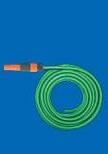








Updating your home’s look doesn’t have to be expensive or time-consuming. With a few simple décor tricks and the right colour choices, you can transform your space with minimal effort.
You can add personality to your home without a full renovation. Whether you’re refreshing a single room or your entire home – small changes can make a big difference. Dulux’s Colour of the Year 2025, Human Colour Story, offers a beautiful palette of colours designed to create warmth, comfort, and connection – perfect for making your home feel inviting. Here are some expert tips to help ensure smooth sailing with your next DIY project that are sure to enhance your home’s look and feel.
1. Start with Colour: Paint an Accent Wall
One of the quickest ways to refresh a space is colour. The Dulux Colour of the Year 2025 palette features warm, earthy tones inspired by human connection. Try painting one wall in a soft, grounding shade. An accent wall instantly adds depth and character to any room. “Colour plays a huge role in setting the mood of a space. The Dulux Colour of the Year 2025 palette was designed to bring a sense of comfort and connection to our homes, reflecting the warmth and togetherness we crave in our daily lives,” says Palesa Ramaisa, a Dulux Colour Expert.
2. Upcycle Old Furniture with a Fresh Coat of Paint
Instead of buying new furniture, give your existing pieces a makeover. A worn-out coffee table, bookshelf, or dresser can be completely transformed with a coat of paint. Use a rich colour for a bold statement or a soft one for a fresh, airy feel.
3. Layer Textures for a Cozy Feel
To create a more inviting space, layer different textures – think woven rugs, chunky knit throws, and linen cushions. Pairing soft fabrics with wooden or metallic accents will add dimension and comfort to your space.
4. Refresh Your Walls with DIY Art
Can’t find the perfect artwork? Make your own! Use leftover paint from your accent wall to create abstract designs on canvas. The Dulux Colour of the Year 2025 colour range offers versatile tones that blend beautifully
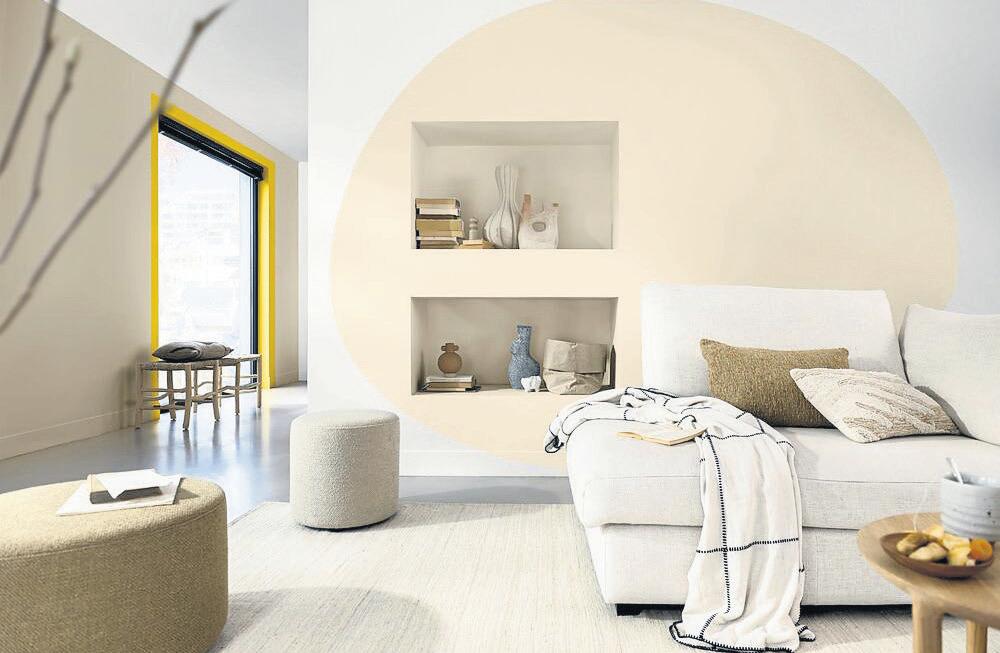
together – experiment with brush strokes and layering for a unique piece that fits your space.
5. Add Life with Plants
Nothing brightens up a home like greenery. Indoor plants such as ferns, succulents, and peace lilies not only purify the air but also bring a fresh and natural feel to your décor. Use stylish pots to tie into your colour scheme.
6. Revamp Your Kitchen or Bathroom with Painted Tiles
If your kitchen or bathroom tiles are outdated, there’s no need to replace them – just paint them! You will need to clean the tiles thoroughly and allow them to dry. If there is any mould on the grouting or sealant, use a bathroom fungicidal spray to kill it before applying any paint. Mask off the silicone sealant and edges of the tiles, then apply a coat of Dulux Supergrip All Purpose Primer and allow to dry, and finish off by applying two coats of the Dulux Pearglo or Dulux Quick Dry Satinwood. Painting your tiles in deep, grounding shades can give it a modern, refreshed look.
7. Play with Lighting for Mood Enhancement
Good lighting makes all the difference. Swap out white lights for warm LED bulbs, or add fairy lights and candles for a cozy ambiance. Using lampshades in Soft Peach or Golden Glow will enhance the warmth of your space.
“Your home should reflect who you are. By playing with colour, texture, and lighting, you can create a space that not only looks good but feels good too,” adds Ramaisa.
With a little creativity and the right colour choices, you can transform your home to feel comfortable, stylish, and truly yours.



With the winter season knocking on our doors it is an appropriate time to look at the solar panels you have installed at home. Are they ready for the change of season and weather patterns, and when last did you check the wiring?
“I must emphasize the importance of using properly registered solar installation companies to ensure safe, high-quality installations”, says Dr Rethabile Melamu, CEO of the solar PV industry association SAPVIA. “Through our PV GreenCard programme, SAPVIA promotes industry standards and compliance with national regulations.”.
The PV GreenCard “as-built report” documents the installation process and ensures adherence to best practices. It is issued by certified installers who have undergone specific solar installation training and assessment in conjunction with the Certificate of Compliance.
“Using certified installers not only protects the reputation of the solar PV industry,” says Melamu, “but also safeguards end-users by ensuring installations meet both local and international standards. This initiative is part of our effort to support the growth of the solar PV market in South Africa while maintaining safety and quality.”
A solar system, at the heart of it, needs to be treated as a piece of electronic equipment that should be looked after and maintained, in the same way you would look after your car (for example). Most solar systems in South Africa are hybrid, with components such as solar panels, wiring, inverters, batteries and monitoring software.
Solar panels themselves tend to be low-maintenance, but they are exposed to the elements every day and should be checked to see if there is any dust that has gathered or anything else that impacts the panels and their ability to generate power for you.
“We encourage homeowners to monitor their energy output closely via their monitoring software and apps,” Melamu says. “An energy output decline of 15% necessitates cleaning; for optimum output a minimum of twice a year cleaning is recommended.”
Depending on the inverter and battery pack you in-

stalled you could look at a lifespan of around 5 to 15 years, although older systems may not have such a long lifespan as newer models could offer. Quality inverters and batteries come with longer warranties and tend to be more durable and reliable. The usage patterns for both inverters and batteries also affect the life span, the frequency of use and power drawn tend to shorten the lifespan. To extend the lifespan of inverters and batteries, regular cleaning of dust and debris, regular inspection of connections and monitoring of wear and tear are recommended.
“If your system was installed some time ago then it may be a very good idea to get an accredited service provider to visit as soon as possible,” says Melamu. “Ask them to check the wiring and whether they are still safe and secure, and that they are also properly insulated. This is where the PV GreenCard As-built report comes in handy, as it documents models and warranties of components.
“With winter approaching it is certainly a very good idea to stress-test your solar system now before the cold weather hits. Fixing small problems today could help you avoid big and expensive problems down the line.”
• SAPVIA governs thesolar PV industry in South Africa. For more information, visit www.sapvia.co.za
With South Africa’s hot summers having an air conditioner in the home is a pleasure that the whole family enjoys. However, an air conditioner that is not properly maintained can lead to skyhigh electricity bills for disappointing levels of cooling.
Keeping your air conditioner in good working order requires regular maintenance. Much of the maintenance you can do yourself, although it is a good idea to have a technician come out to service the unit at least once a year.
Given South Africa’s often dusty climate, cleaning your air conditioner filter is an essential task that should be done at least once a month when the unit is being used; and before using again after a period of no use during the cooler months.
Dirty filters block the airflow within the air conditioner, which has a significant impact on both power consumption and cooling. They can also compromise the air quality within the home, which could have health consequences for your family.
Some air conditioners contain filters that can be cleaned and reused, while others are only single-use filters and require regular replacement. Even if your filter is the type that can be reused it will still need to be replaced from time to time due to wear and tear. Your owner’s manual will tell you whether your filters can be cleaned and how to do so.
Vacuum your vents
While a duster can be used to keep your air-conditioner
vents clean, it can be time-consuming to do properly. Using your household vacuum cleaner to clean your vents is far quicker and more effective too as dust particles are sucked up and not allowed the opportunity to settle behind the vents.
If your vents are looking grubby, try using the soft brush attachment for your vacuum to loosen built-up grime.
Once your indoor unit has been cared for it’s time to head outdoors to check on the compressor or heat pump, depending on the type of air conditioning unit. The outdoor component of air conditioners is very often neglected, but their condition determines just how effective and efficient your unit is.
Your first task is to make sure that the unit has a clear space on and around it, paying particular attention to any garden debris that may have piled up in front of it. Your outdoor unit should always have free space around it for optimal airflow.
Having cleared the surrounding space, remove the outer covers of the unit to expose the fins. First, check for any bent fins and gently straighten these with a butter knife.
Your household vacuum cleaner is a handy cleaning tool for your outdoor unit and if you have a soft brush attachment, you can use this to loosen built-up grime. If you use this attachment, be sure to follow the direction of the fins and be gentle to avoid bending any of the fins.
Your garden hosepipe is perfect for rinsing off the fins, but be careful not to have it on a high-pressure setting that could bend the fins. Once complete, replace the outer covers.





Some of our member services include:
• Marketing
• Network / public relations
• Bargaining council
• Training
• Building contracts
• National communication
• Safety service
• Labour relations
The MBA Boland conference centre is situated in Southern Paarl and is ideal for functions, and corporate events.
• Conference room seats 40-80 people
• Secure parking for 30 vehicles
• Projector, projector screen and flip chart
• Enclosed veranda seats 30 people
• Fully equipped kitchen
• Licensed bar




